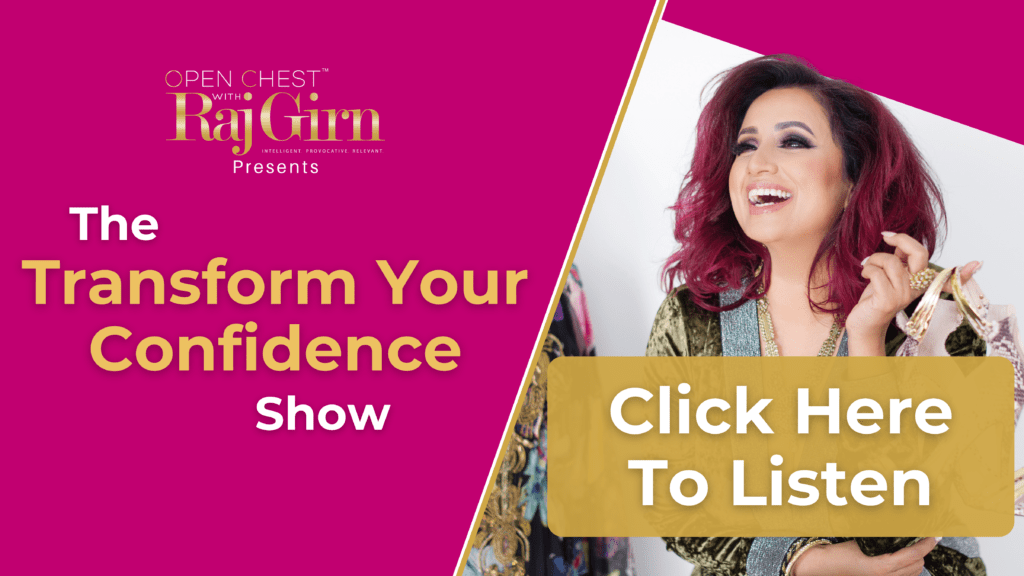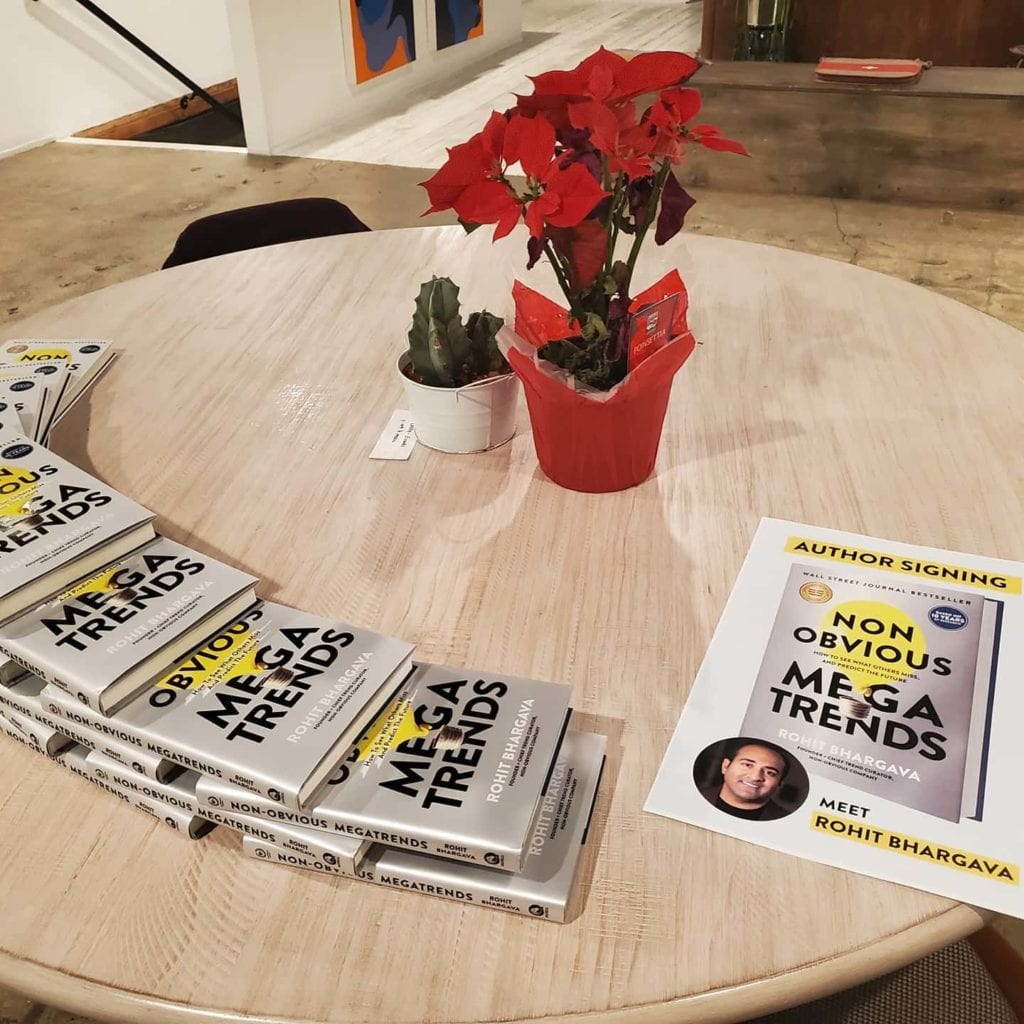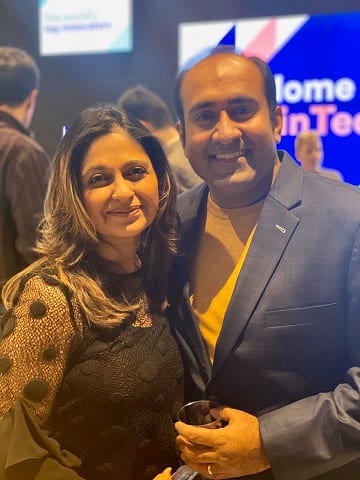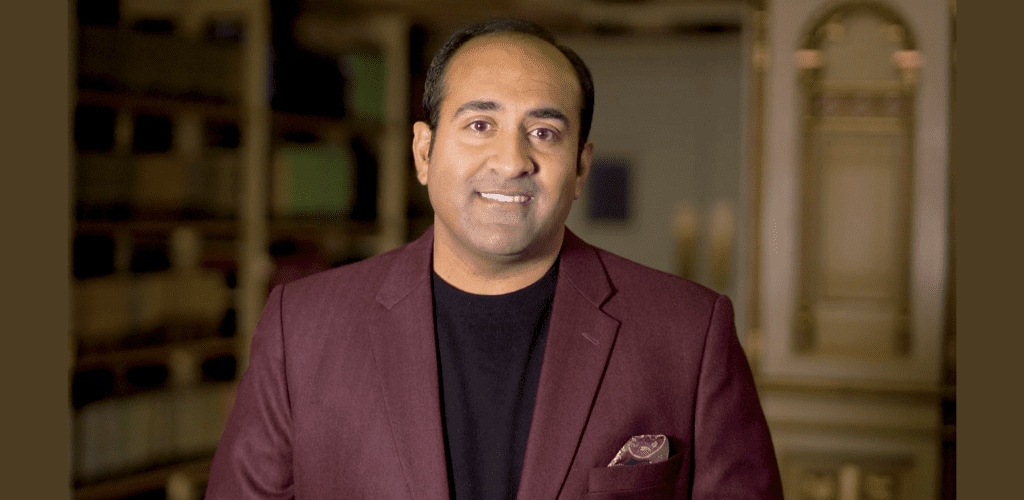Raj Girn: Let’s go. Hi, everyone, thanks for tuning in to another exciting episode of ‘The Transform Your Confidence Show.’ I’m so happy to see you tune in each week. And I really love that you guys are subscribing and you are coming back to me and you’re giving me your thoughts and your valuable insights to this fledgling show. Those of you who haven’t yet subscribe, please do so. Go to our YouTube channel, at The Open Chest® Confidence Academy, or go to our podcast platforms where you can search for us as ‘The Transform your Confidence Show.’
Have you ever wondered why some brands are able to stand out over others and why other brands catapult from what seems like oblivion into overnight success? What do they know that is helping them accomplish this? And how can you tap into this to benefit also? Well, this week my theme is branding and marketing, where I speak with marketing expert Rohit Bhargava in an episode entitled Marketing Methods That Work in Today’s Overload Culture. This is part one of a two-part series with part two airing next Wednesday.
He will be pulling back the curtain with me this week as we deep dive to reveal what the thought leaders and disruptors are doing to not only become and stay top of mind with their brand, but to also insight advocacy culture with everyone who touches their brand.
Before I bring him on, here’s a bit about him. Rohit Bhargava is the number one Wall Street Journal best selling author of seven books. He is widely considered to be one of the most entertaining and original speakers on disruption, trends and marketing. He teaches marketing and storytelling as an adjunct professor at Georgetown University and is the owner of IdeaPress Publishing. He is a preeminent voice and thought leader in everything marketing and has keynoted a staggering 32 countries worth of events throughout his career.
Rohit is an honour, mission-inspired individual with a non-obvious thinking mentality for which he created and launched the Non-Obvious Company. This past year, he launched a popular podcast called the Non-Obvious Insight Show, which just closed out an online event called the Non-Obvious Beyond Diversity Summit, which had over 200 speakers participate. And they really brought the idea of diversity and inclusion in today’s world from multiple different perspectives. So you have to go check that out at the website. In his previous life, he spent 15 years as a marketing strategist at Ogilvy and Leo Burnett.
Here is Part One of our conversation:

Raj Girn: Welcome to the show, Rohit Bhargava. Rohit, thank you so much for agreeing to be on the show. This is actually my first branding and marketing themed show, so I couldn’t think of anyone better to bring on. And just a really deep dive for that whole conversation, especially with the kind of year and a half we’ve had. How are you today?
Rohit Bhargava: I’m great. And this is one of my favourite topics, maybe my favorite topic. So you have picked a good one for me. I’m very excited.
I’m going to be throwing you in the deep end then. Let’s just get right into it, which obviously is not deep end for you, but let’s just get right into it.
So Rohit, marketing is one of those areas that has so many advantages if it’s done properly. But before we kind of tackle what that is, can you explain in simple terms for anyone out there who really hasn’t been in the wheelhouse of marketing, hasn’t really been exposed to it, but they know that it exists out there and that companies use it for a reason: What is marketing? Especially since a lot of people confuse marketing with the intention of publicity strategy, like they seem to interchange them when they’re very divided row houses?
Yeah, they really are. I mean, the biggest confusion is they confuse marketing with the outcomes and the things that they want to happen. So “I want to get featured here. I want to run this ad over here.” To me, marketing is basically persuasive storytelling. And at the end of the day, if you have great marketing, you are changing the way that people think, what they believe and what they intend to do. So you want to drive them towards doing something; either changing their behavior, changing their beliefs or buying something from you.
“To me, marketing is basically persuasive storytelling. And at the end of the day, if you have great marketing, you are changing the way that people think, what they believe and what they intend to do.” ~Rohit Bhargava
And so how is that different from a publicity strategy? Because often times new brands, when they’re launching something new, they always feel they need to go to market via media houses, and they don’t always focus a lot on the marketing piece. So can you, give us some sort of a differential there for anyone that really doesn’t understand the difference?
Yes. So PR and publicity is one slice of your marketing pie. It’s one element, and what PR and publicity will get you if you do it right is mentions in the media. But it doesn’t include a lot of the other aspects of marketing. It doesn’t include word of mouth. It doesn’t include direct marketing. It doesn’t include advertising. These are all other slices of the marketing pie. And so the first big thing I tend to tell people is figure out what the marketing strategy is going to be, which is a big word and concerns a lot of people. But the analogy I tend to use is if you were a restaurant, you wouldn’t come up with a chicken strategy for just selling chicken. Right? You’d come up with a strategy for your entire experience. You’d have a menu, you’d create all of those things, and chicken would be one of the things on the menu. And like publicity, if you just focus on publicity, or if you just focus on social media, or if you just focus on email, all of those things are chicken strategies. You just focus on one small thing instead of the big idea.
Right. Anyone that’s just joining us, I am talking to Rohit Bhargava. We are talking about when do we use marketing strategy, and especially as it pertains to methodology in today’s overload culture. We’ve just gotten started off with the subject matter and we’re diving right in.
Basically I asked Rohit so far, what’s the difference essentially between marketing and PR, since that seems to be the the fundamental common denominator confusion for most people. So since we’ve kind of tackled that a little bit, Rohit, let me ask you this: Why is marketing considered the foundational requirement to growth of business?
Well, because usually marketing is essentially about accelerating the growth beyond the one client or the one thing that you already have. And when you think about growing any sort of business, what you ultimately want is you want the people who are buying your stuff or engaging with you to talk about you. So you want word of mouth and then you want that to accelerate beyond, so that you reach many more people, more people start coming to you. You don’t have to sit there trying to scramble a business all the time. You want that business to be coming to you. And, so marketing is often seen as the thing to do.
But we get a mistaken perception, I think, a lot of times, because we see these super successful examples. And one of the examples I wrote about was like, you remember when Elon Musk sent his car up into space and had that mannequin in it, and that whole thing was such a big stunt. But Elon Musk, if you ever listen to him in an interview, he always says, “oh, Tesla doesn’t do any marketing because we don’t need to. Everybody talks about Tesla.” But actually, he’d spent close to a billion dollars to put one of his Tesla cars into space, which was marketing. So we look at these celebrities and we’re like, “Oh, they don’t have to do any marketing,” like marketing is just for suckers. We’re spending money on Facebook ads. But all of these things are marketing because they’re telling the story of what you want people to believe in. When Musk put the car into space, what he’s telling you is Tesla can do anything and that’s what people are buying into when they’re buying a Tesla.

Credit: cagspeakers.com
Absolutely. And such an excellent example, especially since he’s one of the richest people in the world right now. Am I right?
And he didn’t get there without doing any marketing, that’s for sure.
He definitely didn’t. So let me just dive a little bit deeper into some of the different pillars of marketing. Can you explain the main types of marketing? And, when should each of these be used?
There’s sort of a framework that we tend to use in marketing called paid, owned, earned. Paid marketing is you buy an ad. So you pay for a magazine ad, you buy a Facebook ad, you buy a billboard. Those are all paid. Owned are your website, your storefront, the things that you actually have control of. Earned is what we talked about before, which is PR and publicity.
And then there’s a fourth category that I added to that which is rented, and rented is your Facebook page, your Twitter account, all of these platforms that you might use to engage with people, but you don’t actually own them. Like Twitter could turn around tomorrow and turn your account off. So it’s not actually yours, right? It’s sort of like renting a house, like you can rent it, but if the person who’s renting it to you says, “Look, I want you out,” then you have to be out. As opposed to you owning your house and you don’t make the payments, you could stay in your house. So these are the different elements of marketing and the way the strategy comes into it, is to say, look, I want to spend more time on this element of marketing and I want to spend more money or more effort on this, because that’s what’s going to pay off for me the most. And that’s what depends on your type of business.
So can a business grow without marketing?
Sure, yeah. I mean, you can grow by selling products in the right place. Look, if I have a table and I set it up and I’m the only person selling water at the end of a marathon that just took place in the desert, I don’t need any marketing. I’m in the right place at the right time and I’m just selling water all the time. But that’s not replicable. And so the challenge is, do I want to continually be selling one thing to one person and hope that I’m always in the right place at the right time with no competition? Who has that scenario in real life where you have the perfect product, everyone wants it, the price is great and there’s no competition for you at all. And you land on that. Yeah, it doesn’t exist. And even if it did exist, it wouldn’t exist for long because other smart people would come along and say, “Hey, I’m going to do that too.”
So, the reason why marketing and branding matters is because it gives you a way of standing out in relation to the competition, which is something we all have to do.
“The reason why marketing and branding matters is because it gives you a way of standing out in relation to the competition, which is something we all have to do.” ~Rohit Bhargava
Absolutely. So, at what stage of business is marketing an absolute must, even if until a certain point the business has been doing predominantly without it? But now we’ve come to a point where growth requires that marketing piece. So when would that piece be in general terms?
So this is one of the misconceptions that I think that a lot of people who start a business or a part of a business have, and say we’ve gotten to this point without doing any marketing. But do you have a logo for your business? Yes. Did you name your business? Yes. Did you register your url for your business? Yes. Those are all marketing. And so you’ve done all of these things even though you don’t think it’s marketing because maybe you haven’t paid for advertising. And so in a lot of people’s heads, they’re like, well, “I don’t do any marketing because I’m not buying ads and I don’t have brochures.” And like the things that we typically consider to be marketing, they don’t have those things. So they think, oh, no marketing, but there’s a whole portion of branding in your business that includes selecting the name for it, figuring out the tagline for it. How do you position your business? Do you have business cards? That’s marketing too. So all of these things that we don’t tend to think of as traditional marketing because they’re not advertising are still elements of your marketing.
So for those people who are quite uninitiated, don’t know that much when it comes to marketing strategy, I mean, if we put it into two wheelhouses of the paid versus the organic, can you give us some ideas of when a person should do one versus the other, if not both?
So, to me, the best use of paid advertising is in two scenarios. Number one, if you have something already that you have created that you want to amplify. So, for example, you have an article that you’ve written somewhere and you want more people to read it. Well, you pay for advertising to get more people to actually read that but you’ve already started with something. That’s one scenario.
The other scenario where it’s worth paying is to get awareness of your thing, whether it’s a service or a product with the right people that you couldn’t have gotten otherwise. So, for example, a lot of people, depending on the product that they have, before the pandemic at least, go to a trade show. Like, if I was launching a candy bar for example, or a snack bar, I’d go to a food trade show and I’d buy a booth there. And then I’d go there and I’d show my product and let people taste it, because I know that the right people, the buyers are going to be there. And so that’s my marketing. So it depends on what you’re trying to get out there as to whether you need that moment in time. Like, if you’re trying to get your granola bar into all of the grocery stores across whatever country you live in, you’re going to have to go where the buyers are. You can’t just sit there sending emails and hoping that they open them and that they like the picture of your granola bar. That’s not going to be effective. So it depends on what you’re trying to get out there as to what you should consider to be worth paying for.
Right. And when would that be? Would that be when the product is ready? You’ve gone through the testings, you’ve done focus groups, you’ve done all the stuff that you can do that tells you that this product is good to go to market and there is a gap in the market for this. Yeah, I mean, it’s the million dollar question, isn’t it?
Well, it’s the million dollar question in some sense, but it’s also the judgment call in some sense. So how complete do you need something to be before you launch it? And what’s your level of comfort with pitching something as coming soon versus here it is finished. I mean, I’ve written many books and every single book I’ve ever written I’ve always promoted before it’s finished. Before the rain is finished. And it’s a very surreal experience, that you’ll have as an author, when you list your book six months ahead of when it comes out on Amazon. And then, of course, you go and buy your own book that you know you haven’t written yet, but you’ll buy it as if it’s like a finished book.

Yeah. And now you’ve got this motivation because you’re like, I just bought my book, which I haven’t written yet, and now I’ve got to go and write, have to be able to hit all the deadlines to then get it out. In that world, you have the cover and you have the positioning for the book and you go out and you start selling even though the book’s not finished, because you know that you need that lead time to get momentum leading up to when it does launch. Now, other stuff you may not want to launch until you actually have something to show, because otherwise it’s too early.
I know in the world of entertainment, when you’re selling a show to Netflix, for example, like you need a pilot, you need something that can give them a chance to see what this is. You can’t just put it on paper with a screenplay necessarily in that situation and just say, I’m just going to hopefully see if they buy it on spec.
Right. You know, in the position that you’re in, if you decide to launch a book similar to like Robin Sharma, who does the same tactic as well, where he’ll talk about his book when he knows when it’s ready to come out and he’s still writing it, he is telling people, he’s expressing it.
You do this as well, I’ve noticed that. It’s kind of different in your case. You know, considering that you’ve had so many books, they’ve all been extremely successful and you are a thought leader in your space. What about someone that’s coming new to the market? Let’s use the same example, someone that’s going to be releasing a book for the first time. What can we share with them since this is a wheelhouse of yours? You do have a printing publishing company as well. What can we tell them they should do so they get the order of things. Now, they’re not known like you. This is their first book.
Well, the thing specifically when it comes to books is you do want to get it out there as early as you can because the buying, for example, for booksellers like bookstores happens far in advance of when the books actually come out. They buy seasonally for the season that’s coming six months later. And so the part of it is in that industry, you have to announce early enough. Otherwise, for example, the industry book review program, like Publisher’s Weekly or Kirkus, they all expect to see a book at least three months before it actually is coming out in order to review it. A long lead magazine, as you know, expects to see it three or four months ahead of when it comes out, otherwise they’re not going to review it.
So there are, gatekeepers like that who expect to see these things ahead of time, whether you’re a known author or not, that doesn’t matter because you have industry guidelines around that. So I would say for anybody, even if you’re a first time author and you’re kind of trying to build your tribe, you still want to get this in front of people as early as you can, because the momentum that you need for people to love it and talk about it is the same whether you’re a known author who has an audience or whether you’re a first time author who’s just building your audience.
“Even if you’re a first time author and you’re trying to build your tribe, you still want to get this in front of people as early as you can, because the momentum that you need for people to love it and talk about it is the same, whether you’re a known author who has an audience or whether you’re a first time author who’s just building your audience.” ~Rohit Bhargava
You know, point in case is, just recently Priyanka Chopra released her memoirs, her unfinished memoirs. And it’s interesting because obviously she’s a first time author, but she’s also amassed a huge tribe, globally speaking.
But if you look at it, Rohit, for anyone out there who feels, “Yeah, marketing, I don’t need it. There’s other ways that I can go to market, I don’t want to put money into something that I’m not sure I’m getting anything out of.” This is a lot of the questions I get from clients when I work with them. They say, “Well, I don’t know, there’s no guarantee.” But that’s a whole other conversation, obviously. But even if you look at her recently, she has been on literally every single media for weeks on end, even doing a virtual book tour. Meanwhile, everyone knows Priyanka Chopra. So case in point, the point that you just made, that you really do need to keep reminding people. I think that’s the big lesson as well with marketing. Why do we keep advertising?
Yeah, I mean, we in the marketing world, we call it frequency. And so you want frequency in terms of being able to remind people over and over again. And look, for somebody like Priyanka Chopra, she can just have her agent pick up the the phone or send an email or whatever and get on to these shows because she’s famous. And it doesn’t really matter whether she’s written a book before or not, because people want to know her story and she has a huge tribe.
Yeah, but she still goes to market. She still goes to market with the book like she doesn’t have a tribe.
She does. I mean, that’s part of her deal. In fact, a lot of times when a publisher takes on a celebrity author, they will require that that author does X amount of appearances. Because at the end of the day, the way I mean, this is totally inside the publishing industry. But for a celebrity like Priyanka Chopra, she would go to a publisher, her agent would negotiate in advance. That’s nonrefundable. That’s basically a loan against the royalties that she would have later on.
And basically her advance is paid upfront. So if they don’t have those clauses, she could conceivably go have the book written, show up a place to turn in her book, she already got paid her million bucks advance and she would be done. She wouldn’t have to do anything else. So they got to protect themselves. So she’s going to have a certain number of appearances that she has to do, no matter what. And same thing with the movies. Like, when she’s starring in a movie, they’ll say you have to do this many appearances. You have to be talking about this movie during this time frame because that’s when it’s coming out. So it’s all architected in that world very specifically.
Absolutely. And actually, in any world, like any world that uses marketing strategy, any industry that uses marketing strategy, they don’t throw paint at a wall. It’s very strategically planned. And there’s so many variables.
It should be.
Well, you hope it is.
Yeah, but not always.

So give me some examples of that, Rohit. Where would you say that it’s not always that case? Because you expect it to be that case with the big boys in any industry.
And it’s definitely not. The bigger the company, the more things go on in the background. So you have different teams working on different elements. A very common scenario is a candy bar goes and launches a campaign on social media saying there’s a sweepstakes and you can get the candy bar and you can win X amount of money. But nobody tells the people who own the website. So, you can’t find the campaign on the website, even though it’s on the social media and it’s only on one social media because only the Facebook team was working on it, not the Instagram team. And so now they’re not aware of it or they don’t have the relationship.
Or you have these scenarios where people will say, “Oh, I had a flight,” back when people were flying “and I had an issue with the flights, I’m going on Twitter.” But I’m tweeting to the account that’s basically doing the marketing, not the customer service account. So now these are all big company issues that you will typically have. But what ends up happening in the end result of that? It’s that there’s no alignment across these different things that you’re doing, and so what ends up happening is you do everything in a campaign mentality. That’s very common. Just like we’re going to run this campaign over here just for this message, and then it’s finished and we’re not going to use it for anything else. And the more international they become, the less learnings get shared.
So they may have a campaign that generated four times the amount of sales of that product in Brazil. But that Brazil team will never relay that campaign to anyone else and no one else will benefit from it. And that happens all the time and vice versa. There might be a campaign here in the U.S. where they spent $10 million and it sucked and they got nothing. And they won’t relay that because there’s no connection between those things. So there’s a lot of big company issues that keep them from being as strategic as you would think they would be.
And I think that we can fall into that even on a smaller scale. Small business owners can fall into that too, because they are constantly thinking “Oh, I’ve heard a lot about clubhouse. I need a clubhouse strategy now. I’ve heard a lot about this thing over here. So I need this strategy.” And again, to my point before, that’s a chicken strategy. If you’re a restaurant, that would be your chicken strategy. We don’t want that. You don’t want to just focus on that one thing and have a strategy for that one thing and forget about everything else. That doesn’t work.
Absolutely. And it actually brings me to a couple of things that I wanted to talk to you about as well. I mean, we talk a lot about disruption. So, the two most common forms of disruption, of course, one is technological advancements, which bring with them different stages of industry disruption. We see that more now than we’ve ever seen, I would say in recent times, just because technological advancements are much more rapid than they’ve ever been.
And so I guess my question with that would be: What do you suggest be a potentially rule of thumb when faced with having to pivot or maybe even reset your entire marketing strategy to align with the disruption that technology brings to your industry?
“Consider what elements of your business is the disruption happening to . . . Sometimes it’s not actually the product or the service that’s causing the challenge. It’s the way that it’s being sold because people are changing the way that they buy things.” ~Rohit Bhargava
So the first thing that I would suggest is to consider what elements of your business is the disruption happening to. Because a lot of times what will happen is, we will see our sales go down, or see that it is more difficult to close a deal and we’ll immediately think, “Oh, I need to change my product. I need change my service.” And sometimes it’s not actually the product or the service that’s causing the challenge. It’s the way that it’s being sold because people are changing the way that they buy things.
I mean, case in point, 10, 15 years ago when I bought Microsoft Office, I would get a CD for Microsoft. When I bought Adobe Photoshop, I would get a CD for that. Now I pay monthly to access it. I don’t get a CD. There’s no way to buy a CD anymore. And that’s an example not of disruption of the product because like Microsoft Word is still Microsoft Word, right? Photoshop is still Photoshop. The way that you buy it has changed from being a product that you buy once and then you keep forever to on demand. You pay for it continually and you get the latest version continually. So that’s an example where you need to look at your industry and say, “Look, do I need to reinvent my product entirely or do I need to get smarter about how people are actually buying it?”
So again, go to market strategy needs to be considered in cases like that, right? Would you say yes? Would you say that technological changes in any industry will always have to consider a change in marketing strategy? Would you say that they both go hand in hand?
It’s interesting because when we see change happen, it creates two types of opportunities. One type of opportunity is, the change is happening. So I need to evolve and I need to be ready for the change and change everything about my business. For example, if I’m selling T-shirts and people want to make personalized T-shirts, I need to add technology to be able to let people design their own T-shirts and then make them. That’s one way of thinking about it. The other way is, if everybody wants to make their own T-shirts, people probably have a lot of shitty T-shirts. So if I make high quality, great design T-shirts and don’t do any of the personalization, I’ll actually stand out because I’ll be the only one who has properly designed beautiful T-shirts. So, there’s an opportunity for strategy there, right?
Where you say, “Okay, either I’m going to embrace the disruption, run towards it and figure out how to make it work.” Or I’m going to be the one who sees the disruption that says, “You know, there’s going to be people who get that and say, I don’t actually want any of that. I would actually prefer the retro version of whatever that experience is.” So like in the food industry, it was slow dieting. Everybody was into fast food. And then you’re like, okay, you can have a slower dining experience and that’ll be cool. Or in the grocery store world, there were a bunch of grocery stores in the UK that created a checkout line that was called the slow checkout. So it was not the automated kiosk, it was a human and it was designed for people who had Alzheimer’s or who needed more time in the checkout. And it was like this beautiful example of empathy and it was going the opposite direction.
“So all of these innovations and disruptions are an opportunity for any business owner to think about, ‘What am I? What is my core thing that I’m trying to offer and promote and that people actually want?’ And maybe that means you run towards the tech and maybe it means that you actually go against the tech.” ~Rohit Bhargava
How do you know which way to go? What should a person be thinking about?
I think that’s a strategy call. And it’s tough to say because it’s not like this one would have worked and this one wouldn’t have. It’s more like did you make this one work or did you make that one work? So a lot of times what happens when we take these choices is we, when we buy into a choice that we think we’re supposed to do, we’re not really bought into it. And so what ends up happening doesn’t work. So a bigger lesson for me, at least as a business owner myself, is the direction that I pick has got to feel authentic for me. Like you mentioned, I have a publishing company with my wife. And we could have taken that publishing company and said, “Look, people don’t buy in print anymore. We’re just going to go digital with everything. We’re going to do print on demand if people want it. But we’re going to do e-books and audiobooks and that’s it.”
We intentionally said in this digital world where everybody can get stuff digitally, people want beautiful, well printed books more than ever. And we’re going to double down not only on printing, but on not ever doing print on demand and only doing beautifully printed books. And that’s going to be the thing that we actually stand out on. And now when we get authors coming to us, like New York Times best selling author who’ve been with big publishers and who’ve been frustrated, one of the reasons they come to us is because they didn’t like the way their book was printed. And they know that when they come to us, they’re going to get a beautifully printed book, because that’s all we do. And that’s been a strength.

Credit: Credit: FB @rohitmarketingauthor
So there’s an example, right? Could I have gone the opposite direction and could we have done just digital stuff and done it well? Probably. But it didn’t feel right, because I know as an author I want to hold a beautiful high quality book. And I figured other authors would probably want something similar.
Absolutely. So is the value proposition right? It’s what your client is the author and they value the product piece. And it’s interesting what you did here. What I’m hearing you say that you did here is that you decided on the type of author you wanted to niche down on, right? Like you could have gone either way and you decided to go this way.
Clearly, it’s been successful because, anyone that creates something, they want something to stand for it. And books are the obvious example. Everybody wants to be able to hold that book even in today’s society.
So it’s interesting that you decided to do that. And it’s actually bringing a thought into my mind as well. I do a lot of coaching, consulting and mentoring. I’ve been doing it for the last about five years and more, and in the media, communications, branding space. And a lot of coaches come to me that want to brand, they want to learn how to brand their products, and they want to be able to find their niche in the big wide world that we call the online web. So, what happens Rohit is that these coaches that come to me and they’re saying, “Look I want to be able to brand.” So we have to figure out what their brand message needs to be and all of the different pieces that go with that.
And oftentimes, more often than not, they come to me and they say, “Raj but the coaches are doing this online. So I want to do this.” And I said, “But where’s the pattern disrupt? Where are you standing out in this huge marketplace where every coach is marketing themselves the same way? How are you going to stand out if your visual branding is aligned with them?”
This is kind of the case in point of what you just talked about, the publishers going digital. Because the goal is to sell as many units as possible. So they’re motivated by currency. And here you are. You’ll go in a very different direction where you’re putting the power in the hands of what a publisher really wants. And that puts the value of the product in their hands. And as a publisher, you would understand that as a book writer, as an author, you understand that relationship that you have with the product, which oftentimes a publishing house may be looking more at the currency piece and not so much as all the other variables that are also perhaps equally as important. So, I mean, I just want to share that with you.
Yeah. No, it’s absolutely right. I think that what it comes down to, at least with the author publisher thing, is the way that you’re treated as an author when you sign a deal with a big publishing house is an employee relationship. I mean, you got paid the advance and now you’re working for them. You write to them and they make all the decisions. And a lot of our authors, especially the higher up you get with business authors, are used to being entrepreneurs. They run their own businesses, they’re CEOs, they’re founders. And if you say to somebody like that, “Hey, now you’re an employee of someone else,” that’s not a positive relationship for them because they don’t like that relationship. They don’t want that relationship and they expect a different level of control.
And so it’s certainly not that other publishers are not doing print books. They definitely are. We’re not the only publisher who is doing print. It’s that what we’re doing is we’re authors-centric in how we do everything. So we focus on what the author wants first because we work for the author, not the other way around. And that is the difference with this business model that we have here, and that’s why authors like it.
Thank you so much for staying until the end, guys. I really hope you enjoyed this show, will action the many insights that was shed. If there’s one takeaway that I always share at the end of each and every show is this, that in order to create a bulletproof strategy, you must marry knowledge with action and accountability. Without these working together, you are limiting your capacity to actualize your greatness. And trust me when I say this, I know what it feels like to be on both sides of that fence.
So if you’re at a point in your life where you’re struggling to figure out how to action the next really, really great growth journey in your life, I want you to keep tuning into this show because we will be bringing multiple different ways that you can action the knowledge that we bring to the table. And you can find accountability through the insights and through the wisdom that is shared, because at the end of the day, without the action of the knowledge and the accountability to support that finding, that next level of growth in your personal and professional greatness becomes a really challenging journey.
And I’m of the firm belief that if you want to ensure that you’re able to get to that next level in your life, that there’s certain things that have to be in place. One is you need to have a vision of where it is that you need to go. Second, you need to have some sort of a guru mentor guide who is already where you’re wanting to go, and can help you action the steps from where you’re at to get to where you want to go, which is where they have got to have already been or they have got to have gone to beyond that phase. Then the other thing is, and I’m a true believer in this, is that when you get there, I really do feel in order for you to be able to maintain a sustained way of ensuring that you continue to be able to excel to the next level, is this other form of energy that’s important and it’s called ‘service.’ It’s the give back. The give back for me in my life and in the life of many people that I’ve actually worked with, and seen greatness happen in those people that we look up to. And we aspire to be like the people that we feel are the untouchables. They are very touchable because what they’ve accomplished is something that each and every person out there listening to this, watching this or even reading this on our blog, you can take those steps and you can implement them. You can action them and you can get to where you need to get to. Because if one person can do it using that formula, so can you.
So I want you to think about that.
“There are other variables that you have to think about, things like where are you at in your journey? What are the tools that you have at your disposal? Where can you go to get more tools to be able to give you the proper road map to get to where you need to get to? What are the mechanisms that you need to ensure that you have the motivation, and the drive is consistent for you to do the work to get there?” ~Raj Girn
These are some of the things that I have really kind of tapped into and honed in on, and they’re the things that I want you guys to sit with. And I want you to take away each and every show with this knowledge. If this show or any other show is has been of any value to you, I want you to do one thing for me. I want you to share with everyone that you feel this kind of show would benefit. And I want you to invite them to our YouTube channel where all episodes are housed, the ‘The Open Chest® Confidence Academy.’ And I also want you to go and tell them to go check it out on podcast stations. And there you just need to search for ‘The Transform your Confidence Show.’
All right, guys, as always, I hope you have a great rest of your week. And I look forward to see you next week when I have another great episode that I feel is going to be very valuable to your journey or to someone that you know. Until then, have a great week.
To Contact Rohit Bhargava: Email: [email protected] Social Media: Facebook, LinkedIn, Twitter.












